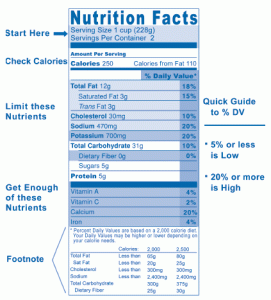
The American Heart Association’s Nutrition Committee strongly advises these fat guidelines for healthy Americans over age 2:
- Limit total fat intake to less than 25–35 percent of your total calories each day;
- Limit saturated fat intake to less than 7 percent of total daily calories;
- Limit trans fat intake to less than 1 percent of total daily calories;
- The remaining fat should come from sources of monounsaturated and polyunsaturated fats such as nuts, seeds, fish and vegetable oils; and
- Limit cholesterol intake to less than 300 mg per day, for most people. If you have coronary heart disease or your LDL cholesterol level is 100 mg/dL or greater, limit your cholesterol intake to less than 200 milligrams a day.
My formula for super heart health is a little more preventative than the AHA because my experience has taught me to err on the side of caution. I recommend that if you want super heart health you should:
- never consume a trans fat
- limit your saturated fat intake to 5%
- limit your overall fat intake to 20%
- only have lean red meat or lean pork once a month
You can serve white meat poultry 3 times a week but the majority of your meals should be fish (not shellfish). Shellfish qualifies as a rare treat like lean red meat and pork. Vary your proteins from animal protein to vegetable protein (legumes and whole grains) and make sure you are getting enough fiber in your diet to keep things running smoothly. For example: beans have 9 grams of protein, peas have 7 grams of protein and asparagus 3 grams per cooked 3.5 oz. Use these great protein alternatives to create better heart health and be sure to add whole grains to your diet. You don’t have to give up your favorite recipes and meals, but you do have to learn to substitute heart healthy alternatives. Give up the white pastas and go for the whole wheat, kamut, quinoa, brown rice or spelt pastas. (You’ll need to pay attention to each one the first time you cook them as they differ in texture and boiling requirements from the white flour pasta you are used to.)
Read Labels!
Many foods have hidden saturated fats in them, so read the label before you purchase and get the ones with the lowest fat content.
Watch your intake of fats and you’ll be on the road to a healthier heart. Start by reading labels. We’ll have more on that subject next week.

I recently found out in July that I am deabitic, have high blood pressure and high cholesterol. Since then I have lost 40 pounds and have come off my blood pressure medication. I have madea lifestyle change, not a diet. It’s been really hard tho to figure out what to eat. I have to look out for so many different things. Could you recommend some good things for me to eat? I’m bumbling and stumbling way through this the best I can.
Hi Gabriel,
There are some very easy recipes here on my website but for many more great, heart healthy recipes that help with blood pressure and high cholesterol, I recommend my book, the Heart Easy Cook Book. You’ll learn how you can eat to support your heart and prevent heart disease, learn my personal discoveries about cooking for heart healthy and get recommendations for fantastic heart-healthy products you should be using instead of the ones that are killing you!
https://www.hearteasy.com/heart-easy-cookbook/
Love, Kac